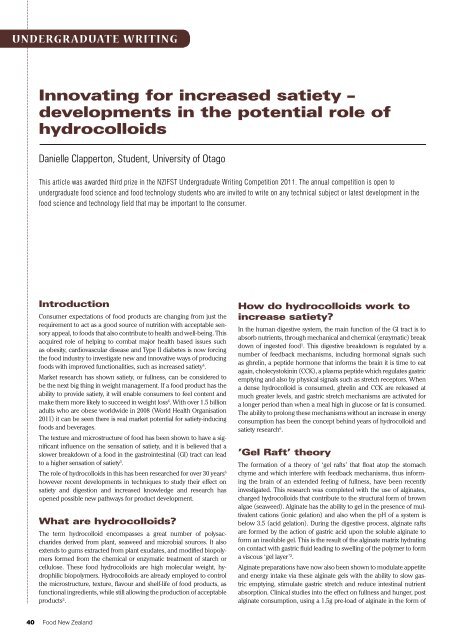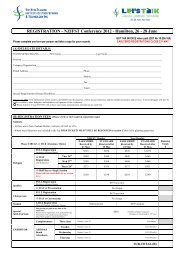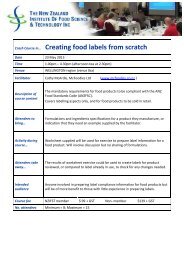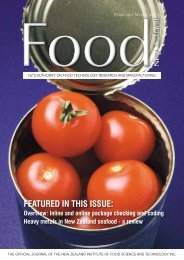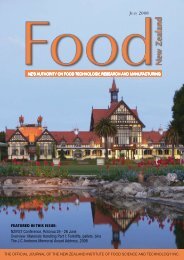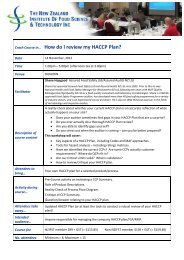FEATURED IN THIS ISSUE: - NZIFST - The New Zealand Institute of ...
FEATURED IN THIS ISSUE: - NZIFST - The New Zealand Institute of ...
FEATURED IN THIS ISSUE: - NZIFST - The New Zealand Institute of ...
You also want an ePaper? Increase the reach of your titles
YUMPU automatically turns print PDFs into web optimized ePapers that Google loves.
UNDERGRADUATE WRIT<strong>IN</strong>GInnovating for increased satiety –developments in the potential role <strong>of</strong>hydrocolloidsDanielle Clapperton, Student, University <strong>of</strong> OtagoThis article was awarded third prize in the <strong>NZIFST</strong> Undergraduate Writing Competition 2011. <strong>The</strong> annual competition is open toundergraduate food science and food technology students who are invited to write on any technical subject or latest development in thefood science and technology field that may be important to the consumer.IntroductionConsumer expectations <strong>of</strong> food products are changing from just therequirement to act as a good source <strong>of</strong> nutrition with acceptable sensoryappeal, to foods that also contribute to health and well-being. Thisacquired role <strong>of</strong> helping to combat major health based issues suchas obesity, cardiovascular disease and Type II diabetes is now forcingthe food industry to investigate new and innovative ways <strong>of</strong> producingfoods with improved functionalities, such as increased satiety 4 .Market research has shown satiety, or fullness, can be considered tobe the next big thing in weight management. If a food product has theability to provide satiety, it will enable consumers to feel content andmake them more likely to succeed in weight loss 6 . With over 1.5 billionadults who are obese worldwide in 2008 (World Health Organisation2011) it can be seen there is real market potential for satiety-inducingfoods and beverages.<strong>The</strong> texture and microstructure <strong>of</strong> food has been shown to have a significantinfluence on the sensation <strong>of</strong> satiety, and it is believed that aslower breakdown <strong>of</strong> a food in the gastrointestinal (GI) tract can leadto a higher sensation <strong>of</strong> satiety 5 .<strong>The</strong> role <strong>of</strong> hydrocolloids in this has been researched for over 30 years 6however recent developments in techniques to study their effect onsatiety and digestion and increased knowledge and research hasopened possible new pathways for product development.What are hydrocolloids?<strong>The</strong> term hydrocolloid encompasses a great number <strong>of</strong> polysaccharidesderived from plant, seaweed and microbial sources. It alsoextends to gums extracted from plant exudates, and modified biopolymersformed from the chemical or enzymatic treatment <strong>of</strong> starch orcellulose. <strong>The</strong>se food hydrocolloids are high molecular weight, hydrophilicbiopolymers. Hydrocolloids are already employed to controlthe microstructure, texture, flavour and shelf-life <strong>of</strong> food products, asfunctional ingredients, while still allowing the production <strong>of</strong> acceptableproducts³.How do hydrocolloids work toincrease satiety?In the human digestive system, the main function <strong>of</strong> the GI tract is toabsorb nutrients, through mechanical and chemical (enzymatic) breakdown <strong>of</strong> ingested food¹. This digestive breakdown is regulated by anumber <strong>of</strong> feedback mechanisms, including hormonal signals suchas ghrelin, a peptide hormone that informs the brain it is time to eatagain, cholecystokinin (CCK), a plasma peptide which regulates gastricemptying and also by physical signals such as stretch receptors. Whena dense hydrocolloid is consumed, ghrelin and CCK are released atmuch greater levels, and gastric stretch mechanisms are activated fora longer period than when a meal high in glucose or fat is consumed.<strong>The</strong> ability to prolong these mechanisms without an increase in energyconsumption has been the concept behind years <strong>of</strong> hydrocolloid andsatiety research 6 .’Gel Raft’ theory<strong>The</strong> formation <strong>of</strong> a theory <strong>of</strong> ‘gel rafts’ that float atop the stomachchyme and which interfere with feedback mechanisms, thus informingthe brain <strong>of</strong> an extended feeling <strong>of</strong> fullness, have been recentlyinvestigated. This research was completed with the use <strong>of</strong> alginates,charged hydrocolloids that contribute to the structural form <strong>of</strong> brownalgae (seaweed). Alginate has the ability to gel in the presence <strong>of</strong> multivalentcations (ionic gelation) and also when the pH <strong>of</strong> a system isbelow 3.5 (acid gelation). During the digestive process, alginate raftsare formed by the action <strong>of</strong> gastric acid upon the soluble alginate t<strong>of</strong>orm an insoluble gel. This is the result <strong>of</strong> the alginate matrix hydratingon contact with gastric fluid leading to swelling <strong>of</strong> the polymer to forma viscous ‘gel layer’².Alginate preparations have now also been shown to modulate appetiteand energy intake via these alginate gels with the ability to slow gastricemptying, stimulate gastric stretch and reduce intestinal nutrientabsorption. Clinical studies into the effect on fullness and hunger, postalginate consumption, using a 1.5g pre-load <strong>of</strong> alginate in the form <strong>of</strong>40Food <strong>New</strong> <strong>Zealand</strong>


